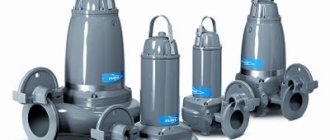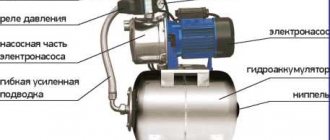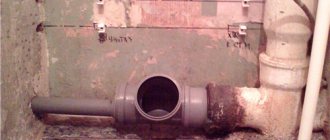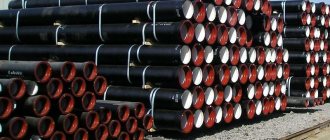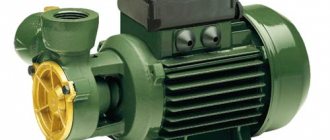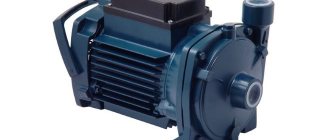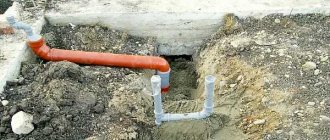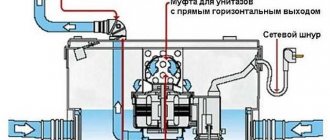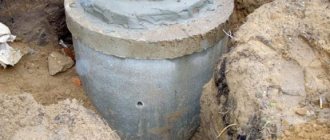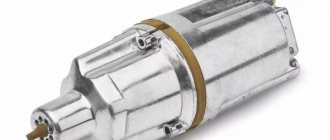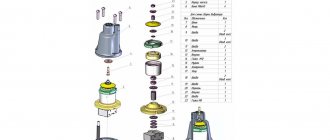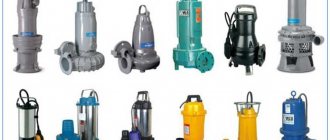Sewage pumping station (SPS) is a hydraulic structure for pumping domestic, storm and industrial wastewater. It is installed between the plumbing components of the building and the sewer main (septic tank), when it is impossible to organize a gravity discharge. The size of the stations can vary from a small tank behind the toilet to huge underground structures serving an entire village or region. The latter are of little interest to us - they are mainly ordered by the state. But modular sewage pumping stations, which can be installed on a site near the house, may be of interest to many.
Areas of application and purpose of CNS
A sewage pumping station (SPS) is an integral complex of hydraulic equipment, which is designed for pumping storm water, industrial and domestic wastewater when their gravity discharge is impossible.
Pumping stations can have an additional horizontal cavity to distribute sludge over a larger area, which allows for less sludge removal
CNS is used mainly in the following cases:
- The geodetic level of tanks and pipelines from which wastewater is discharged is located below the sewer or cesspool
- Lack of physical ability to organize straight-line gravity drainage of wastewater or a small slope of the sewer pipe, which threatens its regular clogging.
- The cesspool or central collector is located far from the source of wastewater.
Cottage villages, country houses, as well as industrial facilities located far outside the city and remote from the centralized sewer network are equipped with sewage pumping stations.
the installation of a sewage pumping station with high quality, on time and at the best cost.
The AKS group of companies carries out both complex installation of a sewage pumping station (sewage pumping station) and supervises the installation of a sewage pumping station. We offer pumping stations with Grundfos, Wilo, Flygt pumps, as well as with pumps of other well-known brands; we ship our products throughout Russia. Pumping stations were supplied to Moscow, St. Petersburg, Novosibirsk, Kazan, Vologda and other cities.
General principles of installation of a sewage pumping station - sewage pumping station
1. The personnel installing the pumping station must have the appropriate qualifications and permission to perform these types of work. 2. The bottom of the pit should be a compacted layer of sand 300 mm without stones. 3. A finished reinforced reinforced concrete slab 250 mm thick is cast or installed on the sand layer. 4. The edges of the reinforced concrete slab must protrude at least 1 meter from the edges of the bottom of the housing. 5. Secure the body to the reinforced concrete slab by passing anchors through the skirt at the base of the bottom. 6. Connect the inlet and outlet pipes to the corresponding pipelines. !!!It is prohibited to connect other inlet and discharge lines to the discharge pipe leaving the pumping station. 7. Consistently fill the pit along the edges of the pumping station housing with a 500 mm layer of sand, compacting the layer each time. 8. If the body is located in a parking lot or roadway for medium and heavy vehicles, then it must be filled on top with a reinforced concrete load slab, the width and length of which must be at least 0.5 m greater than the width and length of the product. 9. If the housing is not installed under a roadway, prevent accidental collision with the area under which it is installed. The safety zone should be 1 m away from the edges of the building along the perimeter of the area. 10. Install a ventilation pipe of the required height into the ventilation pipe on the roof of the housing, and put on the ventilation deflector included in the housing kit.
Installation instructions for sewage pumping station
1. The bottom of the pit for installation of the pumping station should be a rectangular platform covered with a 300 mm layer of compacted sand. Sand for general construction purposes, sea or alluvial in accordance with GOST 8736-93, sifted with a mesh with a cell of 5x5 mm or less. 2. The sand layer must be thoroughly compacted with a tamping machine before installing the pump station. 3. In order for the pump housing to be stable, immediately after installation in the pit, it must be filled with water to 250 - 400 mm. 4. Subsequently, fill the recesses between the pumping station of the pumping station and the edges of the pit in all directions with layers of sand 500 mm high, sequentially compacting each layer. Continue filling the recesses to the level of the heights of the inlet and outlet pipes of the pump station. 5. Fill the pump station with water to a level corresponding to the level of the bottom of the outlet tray. 6. Pour a layer of sand on top of the pumping station, align it with the top of the manhole cover and compact it thoroughly. 7. Backfill the soil. 8. If the SPS needs to be installed under the roadway, the SPS installation is carried out in accordance with Figures 1 and 2 of the standard product installation diagram. If the sewage pumping station is located on a parking lot or roadway for medium and heavy vehicles, then the sewage pumping station must be filled with a protective reinforced concrete slab on top. Concrete grade M150, M200, M250 according to GOST 6812-93. The edges of the slab must rest on undisturbed soil for at least 500 mm along the perimeter of the KNS. 9. In the case of installation of the pumping station of the pumping station not under the roadway, prevent accidental collision with the area occupied by the pumping station using fences and/or other means. The safety zone is 1000 mm away from the edges of the pump station along the perimeter of the area (Fig. 3, 4) of the typical product installation scheme. 10. If, after installing the SPS, the possibility of pressure on the bottom of the SPS from groundwater is allowed, the latter must be secured with an anchor (SPS support), as shown in Figures 3 and 4 in the typical SPS installation diagram. 11. The KNS can be fastened to a reinforced concrete slab using nylon belts (or another method). 12. Nylon belts (or their equivalent replacement) are secured with M20 anchor bolts. In each case, the nylon belts must collectively withstand a load corresponding to the mass of the anchor. 13. After completing the installation of the pumping station, the pumping station should not come into contact with stones, concrete, steel and other materials that could damage the fiberglass material of the pumping station body due to minor soil movements and (or) as a result of groundwater pressure, including during work during maintenance of the pumping station station kns. 14. When installing a pumping station at a depth of ? 1.5 m (distance from the ground surface level to the top of the SPS ? 1.5 m), the above conditions must be met and additionally the manufacture of a reinforced reinforced concrete slab at a distance of 300 mm from the top edge of the SPS (Fig. 5, 6), which lies edges to the ground. The edges of the slab must rest on undisturbed soil for at least 500 mm in all directions around the perimeter of the container. * If it is necessary to install a service well(s), when connecting pumps, floats to the control panel of the pumping station, as well as other additional equipment, carry out all the necessary work before backfilling the pumping station.
Supervised installation of KNS
To ensure warranty obligations for the sewage pumping station - sewage pumping station, the following work is carried out as part of the installation supervision: 1. Monitoring the installation of the pumping station body:
- 1.1. excavation of soil for a foundation pit; 1.2. water decrease at high groundwater levels; 1.3. casting a concrete base slab; 1.4. lowering the pump body into the pit and anchoring it with anchor bolts to the base slab; 1.5. connection of drain and pressure pipes; 1.6. backfilling of the pumping station body.
2. Connection and commissioning of pumping equipment:
- 2.1. connecting pumps to guides in the pumping station; 2.2. connecting the electrical part of the pumps (power supply, communication with the control panel); 2.3. hanging floats and connecting to the control panel.
3. Test run of pumping equipment.
| < Previous | Next > |
Classification of sewer stations
The sizes of domestic sewage pumping stations can be very different. They can fit directly behind the toilet and immediately pump wastewater from it in the required direction, or they can take the form of horizontal tanks with a volume of tens of cubic meters dug into the ground.
But it’s not just the size of the CNS that differs. Below are classifications of pumping stations for sewerage according to various parameters.
By installation type:
- Vertical.
- Horizontal.
- With self-priming pumps.
The last type of pumping station involves the forced pumping of wastewater into the station body and its removal from it after treatment.
Image gallery
Photo from
You can even place a mini-sump station in the corner of the bathroom. It produces minimal noise and has an aesthetic body
When valves and flowmeters are located in a separate dry room, their maintenance becomes safe and comfortable
The choice of a sewer system with self-priming pumps often depends on the available budget, because the bill runs into thousands of dollars
SPS with exclusively vertical containers are used mainly in private homes
Mini-KNS for in-house installation
SPS with separately located shut-off valves
SPS with self-priming pumps
External vertical pump station for home
By type of location relative to the ground:
- Recessed.
- Ground.
- Partially buried.
The water pumping station tank with sensors, pumps and shut-off valves can be located in the ground, and the automatic control system can be located on the surface.
According to the equipment control scheme:
- With manual control . Equipment modules are switched on and off as needed by maintenance personnel, who independently check the fullness of the sewer tank.
- Remote . A tank condition monitoring system is used, the data of which is displayed on a remote control panel.
- Automatic . Control is carried out automatically using sensors and relays located directly in the pumping station housing or next to it.
Manually controlled pumping stations are the cheapest, but require personal participation. They are used mainly in country houses and cottages with a small amount of water consumption.
According to the nature of sewerage:
- For domestic wastewater.
- For industrial purposes. Made from materials with increased resistance to chemically aggressive environments and thermal effects.
- For storm networks. Equipped with additional cleaning systems.
- For sludge wastewater. They are most often used in industrial wastewater treatment plants. Equipped with additional devices for processing sediment.
When choosing a CNS model, it is better to focus not on the classification, but on the recommendations of specialists who will select the optimal system for a particular home.
In-house mini pumping station
Let's say a washing machine or bathroom is located in the basement. How then to solve the issue of wastewater disposal, since in this case there is no need to talk about gravity flow? The problem is solved with the help of a mini sewage pumping station (in-house sewage pumping station), which is mounted on the pipe immediately after the toilet (shower drain, washbasin, etc.). It is easy to install yourself, plus it does not require a project or permit. The most powerful of these domestic installations can move wastewater up to 100 meters horizontally.
Mini KNS
Operating principle of mini pump station. When water enters the station tank, an area of high pressure is created. This detects a sensor that sends a signal to turn on the electric motor. When the pump pumps all the liquid from the reservoir into the sewer riser, the pressure will drop and the sensor will turn off the electric motor.
Depending on the characteristics of the pumped medium, in-house sewage pumping stations are divided into several groups:
- Sump station with chopper. Designed for pumping domestic wastewater, including large fractions (from the toilet). They operate at a wastewater temperature no higher than 35o C. The productivity of such installations is 70-100 l/min. The body and cutting mechanism are made of material resistant to aggressive environments.
- Sewage pump for hot gray waste (after a shower, washing machine, kitchen sink, bath). They are operated at temperatures up to 90°C and may have several supply pipes.
- SPS for cold gray wastewater. Relatively inexpensive pumps for pumping cold water from flooded basements or swimming pools.
- Versatile stations for intensive use. Several supply pipes of different diameters, a grinding system, a circuit with two independent pumps, check valves. Can pump hot and cold media.
Unfortunate terrain, remoteness of the sewer line, bathrooms in the basements... There are situations in which only a sewer pumping station can save us from the horror of every homeowner - a cesspool under the windows. The design of a water pumping station for a private house (cottage), as you can see, is quite simple, and if automated, its maintenance will take a minimum of effort and time. But, if you know a cheaper and faster way to pump wastewater, you can share it in the comments.
Equipment selection rules
Next, the criteria will be analyzed, taking into account which it is necessary to select sewage pumping equipment for private use. Analysis of industrial installations is beyond the scope of this review.
The goal when purchasing a pumping station is to purchase equipment that is optimal in terms of power and other characteristics. There is no point in overpaying for systems that will operate at 10-20% of their designed capacity.
When choosing a CNS, the following parameters are taken into account:
- Maximum flow of processed waste.
- Transport distance.
- The difference in geodetic levels between the inlet pipe and the outlet of the pressure hose.
- Degree of pollution, fractional composition and structure of domestic wastewater. There are pumping stations that crush large fractions of inclusions, preventing blockages in pumping equipment.
- Level of wastewater treatment required.
- Equipment dimensions.
There is no single formula for calculating the performance of pumping equipment, therefore the calculation algorithm and the necessary indicators must be specified in the instructions for the purchased pumping station. A typical project for calculating the performance of pumping equipment includes the following steps:
- Determination of daily water consumption and wastewater volume.
- Construction of an approximate schedule for the flow of sewage wastewater during the day.
- Calculation of minimum and maximum sewer flow.
- Determination of the required productivity of the pumping station, taking into account the contamination of wastewater.
After determining the above parameters, you can begin to select the appropriate equipment.
The price of a pumping station is influenced by the manufacturer’s brand, the maintainability of the product, and the possibility of service. It is especially not recommended to purchase cheap pumps if they are expected to be used daily, and there are no reserve tanks or an additional pump for drainage.
KNS - how it works
The first pumping station appeared in Moscow during the construction of a central sewerage water supply system. At that time, the population of the capital was small, industry was poorly developed, so the only sewage pumping station in the Proletarskaya metro area collected gravity wastewater from the entire city. The building is no longer functioning, but has survived to this day, and an interesting water museum has been opened on its territory. Using steam engines and pumps, waste was transported to the Lublin filtration fields.
As the city developed, the infrastructure of sewerage facilities improved and became more complex. The largest KNS was launched in 1980. It collects wastewater from the central part of the capital. According to the water utility, the Central Station is the most powerful in Europe.
The specificity of the operation of the pumping station is associated with significant gas formation. To regulate pollutant emissions (the most unpleasant is hydrogen sulfide) from the station, city water utilities began installing air purification filters
First, wastewater flows through underground collectors into a receiver. Then it is divided into several streams and passed through grates with large holes. They collect large debris that can break equipment. By the way, users often throw anything into the sewer, so the amount and range of garbage caught is amazing.
The filtered wastewater enters the distribution chamber and is driven further through the pipeline under pressure. Using a valve system, one pump can be connected to different pressure pipes. The power of one motor can be compared with a subway train, and its weight is almost 20 tons. To prevent the equipment from flooding in the event of an accident, it is placed above the pumps and pipes.
The productivity reserve ensures stable operation during repairs and preventative maintenance. The control of the pumping station is fully automated and its proper operation is monitored by a staff of operators around the clock. Constant analysis of the volume of wastewater shows that over the past decades its quantity has decreased, although the city is steadily growing. This is the result of the massive installation of meters and the closure of a number of large enterprises and automobile factories.
Design and principle of operation of the CNS
The design of modern pumping stations should be considered in two main versions:
- sololift;
- sewer station for a country house or cottage.
There are no fundamental differences between these devices. But sololifts are a single ready-made piece of equipment that you can buy on the Internet and connect yourself, and sewer stations are formed from separately sold parts for a specific external sewerage project.
Portable mini stations
Portable pump stations of the Sololift type have a compact appearance and are installed near plumbing equipment. It is installed either in the basement of the house or in the bathroom itself. Sololift ensures the removal of sewage as it enters the device body.
When connecting a large number of sewer connections to a mini-sewage station using tees, it is necessary to take into account that the pump performance may not be sufficient to pump the incoming liquid
The main structural components of the sololift are:
- sealed housing with pipes and holes;
- engine;
- impeller with cutting edge;
- automation.
When water enters the device, the automation is triggered and the engine is turned on. As a result, liquid is pumped from the internal reservoir into the pressure pipe. The impeller additionally crushes large fragments to effectively remove suspended particles and prevent clogging.
The sololift body may have 2-5 holes for connecting plumbing fixtures. There is an air valve on top of the device, which allows air to be drawn in from outside when the pump is running. This prevents the water seal in the siphons of home equipment from breaking.
The performance of portable mini-sump pump stations is standard and is theoretically calculated based on the number of supply pipes. After purchasing the equipment, it is enough to connect the pressure hose and sewer pipes to the solofit body, and then plug it into a power outlet.
KNS for a country house
A pumping station for a private home usually has impressive dimensions and is dug into the ground. It will not be possible to find ready-made design solutions of this type on the Internet, and to determine the approximate cost of the equipment, you need to call store managers or leave a request on the sellers’ websites.
Containers made of fiberglass and plastic are more durable. They do not require any maintenance and will last at least 50 years
The station is a sealed container with pumps inside. The main elements of CNS for the home are:
- A storage tank made of plastic, fiberglass, concrete or metal with a volume of several cubic meters.
- Fecal pump. In daily operating stations, two pumps are installed: a working one and a reserve one, the task of which is to raise wastewater to a certain level for its further movement through the pipes by gravity.
- A system of gravity inlet and pressure outlet water pipelines, combining internal sewerage, water pumping station and subsequent collector. The system is equipped with gates and valves that allow fluid to flow in only one direction.
- Automation with float switches. It is recommended to install 3-4 floats at the same time, each of which is capable of turning on a pump. They are inexpensive, so there is no need to skimp on them.
Large home pumping stations have an operating principle that is somewhat different from a sololift. The wastewater reservoir is buried in the ground and connected to the internal sewer drain pipe. When the level of sewage wastewater reaches the level set by regulation, the float mechanism closes the network and turns on the pump.
Pumping of water stops only when the float reaches a level much lower than the one that led to its activation. This scheme allows you to turn on pumping equipment less frequently, reducing operating loads.
Additional floats are designed to activate a backup pump. The water level for starting them is set slightly higher than for the main pump. This allows you to play it safe and turn on backup equipment only in the event of a malfunction of the main one.
Image gallery
Photo from
Flow meters can record both the flow of liquid in a pressure pipe and in a sewer pipe, analyzing eddy flows
The size of the cells of the lattice basket is selected based on the nature of the expected drains
The control panel must be equipped with an alarm that is triggered in the event of a breakdown of the pumping equipment
Sorption filters are relevant only in the case of final discharge of wastewater into water bodies
Sewage flow meter
Wire basket for filtering large debris
Pumping equipment control cabinets
Backfill for KNS filter
Additionally, the KNS can be equipped with the following devices:
- flow meter;
- lattice containers for filtering large debris;
- control and adjustment cabinets;
- ladder for descending into the container;
- vortex flow regulator;
- sorption filters.
The selection of a set of equipment should be carried out only under the supervision of specialists. This will allow you to select components with the most consistent characteristics and productivity.
Sewage Pumping Stations
Sewage pumping station (SPS) is a set of equipment and tanks designed for pumping domestic, industrial or storm water. Provides drainage of wastewater from residential buildings and industrial enterprises. SPS is used in conditions where it is not possible to drain liquid naturally (by gravity) to treatment facilities or discharge sites.
What are modern sewage pumping stations?
produces sewage pumping stations with a capacity from... to... m3/hour. A modern pumping station may consist of just one tank, into which all the necessary equipment is installed. Such systems do not take up much space.
The body of the KNS is made of durable reinforced fiberglass - under conditions of constant exposure to external adverse factors, the material does not corrode and rot and can last from 40 to 50 years.
At the design stage, the function of autonomous operation of the station is laid out, which does not require the presence of an operator. The task of automation is to ensure uninterrupted operation of pumps, monitor performance characteristics, and turn off the system in the event of an emergency. You can monitor the operation of the system via remote access (via the Internet) from anywhere in the world. In the presence of a sewage pumping station, there is no need for deep burial of sewage pipes.
Selection of NCS
The overall dimensions of the pumping station and the thickness of the housing may vary depending on the operating conditions. When choosing a particular station, you must be guided by the following parameters:
- depth of the supply manifold;
- volume and type of pumped liquid;
- type and brand of pumping equipment;
- hydrogeological features of the construction area;
- method of controlling pumps and valves;
- climatic conditions of the area - for northern regions, the hull and hatches are additionally insulated.
Benefits of cooperation with
The equipment is delivered to the site in full factory readiness, which simplifies installation and speeds up the launch of the pumping station. Moreover, depending on the characteristics of the facility where the system will be installed, it will have the required number of pipelines, valves and service areas.
At the customer’s request, we equip the pumping station with additional designs and options - this allows us to make it as functional and easy to maintain as possible under specific conditions. In the manufacture of pumping stations, we use high-tech submersible pumps from global manufacturers, which guarantees long-term uninterrupted operation of the system for several years. This is also facilitated by the automation system, which is manufactured taking into account the specific operating conditions and all customer requirements.
When designing a pumping station, it is necessary to take into account the fact that due to an increase in the amount of wastewater or production volume, the load on the system can be significantly increased.
Cost of the KNS system
The cost of equipment depends on the configuration of the pump station, diameter, height, type of pumps and other characteristics. The installation price includes a standard control panel.
To clarify the cost of equipment and get answers to your questions, fill out the feedback form or request a call. The data you provide will be used to calculate the parameters and dimensions of the station.
Installation of pump station
Due to improper design and installation of pump pumps, the service life of pumps can be significantly reduced, or they will fail more often, which means additional costs for repairs or the purchase of new equipment. Therefore, it is so important to install the pumping station, adhering to all the rules and recommendations.
Pit preparation
First of all, excavation work is carried out at the site, that is, a pit is dug using a mechanized or manual method. When using special equipment, the bottom of the pit is not fully excavated. This is done to prevent excessive deepening. Therefore, the final preparation of the bottom is done manually. The depth of the pit is calculated using the formula NkNS-0.20 + 0.10 + h slab (in meters).
Sand preparation
At the bottom of the pit, a sand cushion 150-200 mm high is formed, on which the formwork is installed. All this is poured with concrete - the choice of concrete brand is based on its moisture-resistant qualities. The surface of the base plate must be perfectly horizontal in order for the pumping station to maintain its high functionality.
Station installation
The installation of the pumping station is carried out in strict accordance with the installation project. The station is moved with a crane, being careful, that is, avoiding shock loads that could lead to damage to the housing and a possible violation of its tightness. The structure is attached to the base formed at the bottom of the pit using anchor bolts.
Backfilling of KNS
The station installed in the pit is not backfilled immediately, but in layers, using sand or soft soil that does not contain large solid inclusions. More often they choose sand, since, due to its free-flowing properties, it does not exert strong pressure on the body and does not deform it. The soil is poured to the level of the supply and pressure collectors. For compaction, the soil is spilled with water. When backfilling the station, the following conditions must be observed:
- Soil compaction cannot be carried out closer than 30 cm from the station body.
- The use of mechanical vibrators weighing more than 100 kg is prohibited.
The soil around the station should not freeze. In northern regions, it is additionally necessary to use insulation, which is foam plastic or other material.
Connecting communications
After the casing of the sewage pumping station is partially filled up, they begin to connect the pipes of the pressure branch and the incoming collector. Upon completion of these actions, the pit is backfilled to the level of the ground surface. When installing a mini-station, its installation is not very difficult; a person with basic knowledge in the field of plumbing can handle it. The main thing here is to adhere to the rules: ensure the tightness of the connections and correctly install the submersible pump.
Start-up work during installation of pumping station
Includes checking all systems of the pumping station for the correctness and perfection of their functioning. Each of them must accurately perform the tasks assigned to it. It is mandatory to check the operation of universal float sensors, as well as the correct connection of hydraulic communications and switchboard equipment. The degree of operability of the pumping equipment is established. To obtain the most accurate results, equipment is tested in various situations: during normal or emergency operation and in peak mode. This allows you to make sure that all components and components of the sewage pumping station are free of defects and will ensure its uninterrupted operation during the entire warranty period of its operation.
Checking the operation of water level sensors
The first sensor is a low level sensor. The remaining three are top level sensors. The correct setting of the second sensor is checked experimentally: clean water is poured into the pipeline and it is observed whether the sensor is triggered when the water reaches a certain level. At the same time, the operating time of the pump is recorded, which normally should be about 7-10 minutes. If you deviate from the above conditions, it is necessary to adjust the position of the sensor. The operation of the third sensor is checked in the same way. To check the operation of the fourth sensor, an emergency situation is artificially created. The operation of the sensor is considered correct if, when lifting the sensor manually to the position in which it should operate, the “emergency” light on the control panel lights up. After completing all stages of commissioning and commissioning work, an act is drawn up, which is signed by representatives of both parties: the customer and the contractor.
Maintenance and repair of pump station
Timely repair and maintenance of the pumping station allows it to function at maximum capacity. All processes in the sewage pumping station are carried out automatically. In this regard, experts do not recommend carrying out maintenance and repair of the pumping station yourself - in order to avoid illiterate actions that can lead to disruption of the automation and negatively affect the operation of the station as a whole. Maintenance and repair of the pumping station includes:
- external inspection and cleaning of the body;
- inspection of pumps and troubleshooting them;
- test runs of equipment with measurement of performance characteristics;
- flushing of pipelines;
- changing oil, gaskets and worn mechanisms.
All of the above procedures are not mandatory, but are performed if necessary. To reduce the time spent on maintenance and repair of the pumping system, at the design stage it is necessary to provide for easy access to each of its mechanisms.
The service organization must always be ready to carry out repairs of any complexity. has all spare parts for repairs, so it carries out repair work as quickly and efficiently as possible.
Supply and replacement of pumps, water level sensors
produces custom-made pumping stations of any designs and sizes, as well as complete pumping stations in a standard version. The equipment is manufactured in strict accordance with the characteristics of the facility where the station will be installed. The pumping station kit includes pipelines, submersible or self-priming pumps, control cabinets and other components. We offer only high-quality pumping equipment. These are mainly submersible units. To quickly and easily replace pumps in the event of a breakdown, they are initially mounted in a certain way - either on chains or on vertical guides. An emergency or planned replacement of one pump takes approximately 1 hour, and in most cases it is not necessary to suspend the operation of the entire pumping station. At this time, the station continues to function due to the backup pump, which can be stored either inside a special pavilion (if used) or in a warehouse.
Testing of control system
KNS control cabinets are intelligent solutions with extensive control capabilities that ensure optimization of all processes during the operation of KNS. Stable and safe operation of a pumping station largely depends on their functionality.
The development and subsequent installation of a control cabinet includes several stages, including testing. Tests are carried out to check the performance of the shield. The control cabinet must provide:
- starting and stopping pumps according to specified parameters;
- uniform development of pump life, that is, their alternation during the operation of the station;
- protection against overheating and idling of engines by installing a temperature sensor;
- control of inrush currents, protection from emergency networks when voltage increases or decreases and automatic exit from emergency mode;
- selection of automatic or service operating mode of the station (when replacing the pump);
- control over the filling of the storage tank.
Testing determines how well the listed parameters are controlled by the pumping station control cabinet.
Installation instructions for pump station
Installation of household pumping stations is carried out exclusively by qualified workers, due to the high requirements for the accuracy of work and compliance with the sequence of actions. Failure to comply may result in damage to the tank or associated pipes. Next, we will consider step-by-step instructions for installing the CNS for people who want to do it themselves.
The first step is to select the location for installing the pump station. SNiPs require digging a tank at least 20 meters from the walls of a residential building. If geodetic levels allow, then it is advisable to choose a higher site so that a lot of groundwater does not accumulate under the station.
KNS should not be installed on the front side of the house, near children's playgrounds and near picnic areas
The second step is to dig a hole, taking into account the diameter of the container and the location for convenient installation work. If the soil is obtained by an excavator, then work must be stopped 20-30 cm above the design level. Next, the soil must be removed manually with a shovel to maintain the integrity of the soil.
When digging a hole for a sewer tank, you do not need to make it huge. A diameter 1.5-2 meters larger than the size of the container itself will be sufficient.
The third step is to select the type of foundation for installing the water pumping station and install it. To do this, after digging a hole, the soil water content is assessed. If the soil is dry, then you can make formwork and fill it with a 30-centimeter layer of concrete. And if groundwater constantly seeps into the pit, then only a ready-made reinforced concrete slab with a thickness of at least 30 cm is suitable for the foundation.
The concrete base must be strictly horizontal, so when laying the finished concrete slab you need to take care of this in advance.
KNS containers have a skirt or legs for attaching to the foundation. Anchor bolts are used as fasteners, although when pouring concrete onto the ground, metal rods can also be built into the mixture, onto which the container can then be attached.
You should not skimp on the size of the anchor bolts. Their optimal length is 200 mm and diameter is 20 mm. And before laying metal rods in liquid concrete, they must be bent with a hook or the letter G
The fourth step is to install the water pumping station tank on the foundation, secure it and connect it to the drain pipe of the internal sewer system of the house. With a vertical type of station and a large amount of groundwater, it is necessary to load the container with concrete. To do this, concrete is poured around the tank 20 cm above the level of the first stiffener of the station.
It should be borne in mind that after pouring concrete it will be impossible to change the tank, so it is necessary to calculate its volume taking into account the expansion of the house and the increase in the number of its residents
The fifth step is to fill the station with fine soil, the maximum grain size of which is 32 mm. Each layer of earth should be no more than 50 cm. After filling the next belt, it is filled with water for shrinkage and compacted.
This completes the external installation of the pump station. After being fixed in the ground, pumps, sensors, check valves and other auxiliary equipment are installed inside the station.
For safety reasons, it is recommended to close the hatches of sewer tanks with locks, because while playing, children can hide in them and lose consciousness
It would not be superfluous to install an emergency warning system in the house about the critical level of domestic wastewater in the tank, which will warn about malfunctions in the operation of the station.
Installation and maintenance of pump station
In accordance with the requirements of SNiP 2.04.03-85, the distance from the pumping station to residential buildings is taken depending on the station’s throughput. If this parameter is ≤ 200 m3/day, then the sanitary protection zone (SPZ) must be at least 15 meters. Specific average daily water consumption per person is 0.16-0.23 m3/day. A family of 5 people consumes about one cubic meter of water per day. If the wastewater after the pumping station is settled in a septic tank, then the flow rate is taken with a 3-day reserve. In any case, a simple calculation shows that the station’s productivity will be less than 200 cubic meters, which means 15 meters is the minimum that you need to focus on. But, in the end, everything is decided by the KNS project. After approvals, there may even be five meters of the CVD there - the inspectors will not say anything to you.
Installation of pump station
Installation of the SPS (modular) will take place in the following order:
- A pit is dug using a mechanized method. The bottom is compacted with a layer of gravel. On top - 10 cm of compacted sand.
- The formwork for the reinforced concrete base of the pumping station is assembled, after which it is poured. The concrete layer should be no thinner than 30 cm.
- When the concrete reaches grade strength (28 days), the installation of the pumping station begins. The container is leveled, and its base is secured to the foundation slab with anchors. If there is a danger of the station being pushed out by groundwater, then its body is “loaded” with ready-mixed concrete.
- The soil is backfilled layer by layer (50 cm each) and compacted. During the process, gravity and pressure pipelines are connected.
- Pumps are lowered into the tank and connected to guides and pipelines. Float sensors are installed.
- Electricity is supplied to the station and the control cabinet and grounding is done.
- The above-ground part of the tank is insulated.
Typical installation errors
Damage to tank walls, connections or associated pipes can occur if the tank is not installed correctly, tilted or backfilled incorrectly. Such problems threaten manual excavation of the container and considerable financial costs. Therefore, you should sort out typical mistakes in advance so as not to repeat them when installing your own pump station.
- Backfilling of soil was carried out:
- without layer-by-layer compaction;
- large stones;
- frozen ground.
The consequence may be subsidence of the earth with damage or displacement of the internal pipeline.
- Different type of backfill from different sides. If you poured sand into the pit on one side and earth on the other, then over time the container may become distorted, causing damage to the external pipes or the tank itself.
- Incorrect assessment of the amount of groundwater, which causes severe subsidence of the entire sewage pumping station with rupture of pipes and damage to the reservoir.
- Using wedges to level foundation slabs. The consequence may be a gradual displacement of the tank to the side with rupture of pipes.
Only people with geodetic education and experience in installing similar structures can evaluate the correct installation of the SPS. Therefore, you should not trust the installation of this expensive equipment to non-specialized organizations.
Maintenance of external pump stations
A sewage pumping station is not equipment that you can install and simply be content with its operation. The tank and pumps require regular inspection. It is strictly prohibited to go down into the tank or carry out cleaning work on your own! Inhalation of sewer gases can cause sudden loss of consciousness and death if the person is not removed to clean air within a few minutes.
The most profitable option for regular cleaning of a sewer tank is to purchase a gas mask with forced air supply from the surface
When purchasing a water pumping station, it is advisable to immediately sign a contract for its maintenance.
To access the tank and check the equipment, the stations have a hatch, and deep tanks also have a ladder for descent. Monthly or quarterly, the service department must:
- check the automation;
- diagnose the operation of the main and backup pumps, check the oil levels in them;
- remove stuck debris from filters;
- remove silt deposits from the bottom.
In case of urgent emergency situations, an independent inspection of the tank is possible, but it must be carried out in the presence of assistants, with a rope harness and wearing a respirator.
